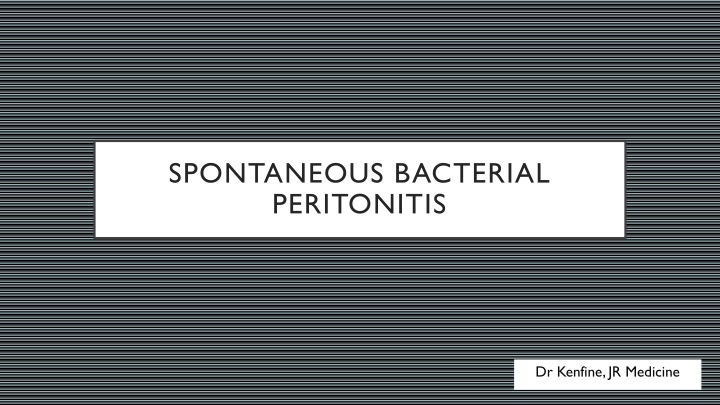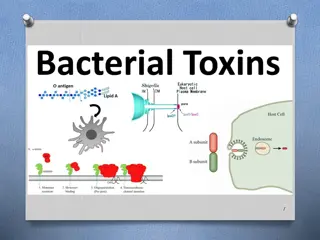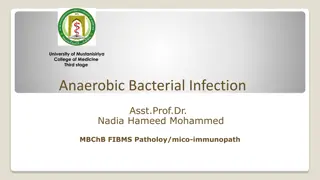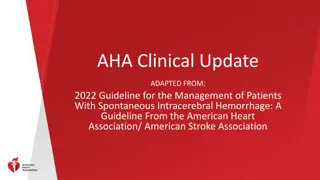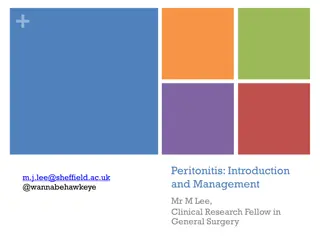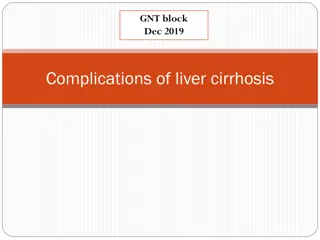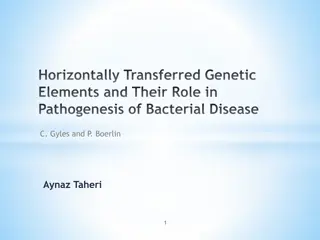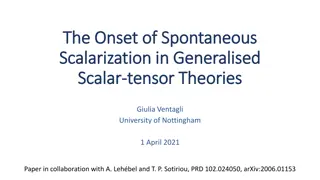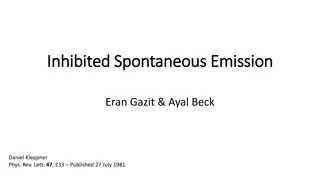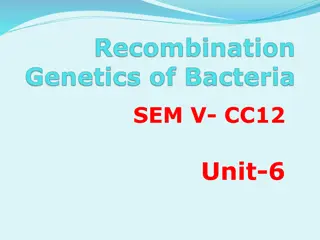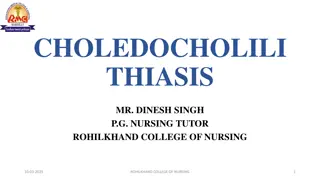Overview of Spontaneous Bacterial Peritonitis
Spontaneous Bacterial Peritonitis (SBP) is an infection of ascitic fluid without an intraabdominal source, commonly caused by gut bacteria like Escherichia coli. It can lead to serious complications in cirrhotic patients and presents with symptoms like abdominal pain, fever, and hepatic encephalopathy. Treatment includes intravenous antibiotics and albumin therapy to reduce the risk of renal failure and improve survival.
Download Presentation

Please find below an Image/Link to download the presentation.
The content on the website is provided AS IS for your information and personal use only. It may not be sold, licensed, or shared on other websites without obtaining consent from the author.If you encounter any issues during the download, it is possible that the publisher has removed the file from their server.
You are allowed to download the files provided on this website for personal or commercial use, subject to the condition that they are used lawfully. All files are the property of their respective owners.
The content on the website is provided AS IS for your information and personal use only. It may not be sold, licensed, or shared on other websites without obtaining consent from the author.
E N D
Presentation Transcript
SPONTANEOUS BACTERIAL PERITONITIS Dr Kenfine, JR Medicine
SBP Spontaneous infection of the ascitic fluid without an intraabdominal source.
ETIOLOGY GRAM NEGATIVE AEROBIC Escherichia coli and other gut bacteria Streptococcus viridans, Staphylococcus aureus and Enterococcus spp. GRAM POSITIVE AEROBIC
If more than two organisms are identified, secondary bacterial peritonitis due to a perforated viscus should be considered
MECHANISM gut flora Bacterial Translocation mesenteric lymph nodes bacteremia and seeding of the ascitic fluid.
Hematogenous spread from a distant source, such as a urinary tract infection (immunocompromised).
In Cirrhosis , elevated level of bacterial overgrowth in the GI tract 1) Prolonged intestinal transit time 2) Reduced protein production by a cirrhotic liver 3) Poor phagocytic and reticuloendothelial system function results in decreased clearance of microorganisms
CLINICAL FEATURES Abdominal pain with tenderness fever Hepatic encephalopathy Paralytic ileus Other symptoms of infection asymptomatic
TREATMENT Intravenous third-generation cephalosporin for 5 days. In addition, intravenous albumin (1.5 g/kg body weight on day 1 and 1g/kg on day 3) has been shown to reduce the risk of renal failure and to improve survival.
Inj Cefotaxim 2gm iv TDS for 5 days Or Inj Ceftriaxone1gm BD or 2gm OD for 5days
PROPHYLAXIS Target groups: 1. Patients with ascitic fluid protein <1.5 g/dl 2. Those with a prior episode of SBP 3. Patients with variceal hemorrhage
LONG TERM PROPHYLAXIS (AASLD) Low protein ascitic fluid <1.5gm/dl Altered renal function S Cr >/equals 1.5gm/dl OR BUN >/equals 25 mg/dl OR DAILY S Sodium </equals 130 mEq/l NORFLOXACIN OR liver faliure Child pugh >/equals 9 points and Total bilirubin >/equals 3mg/dl
The International Ascites Club (IAC) recommended the first drug of choice as NORFLOXACIN 400 mg/OD, administrated orally (or by nasogastric tube) over a minimum of 7 days Alterenate regimens are: TRIMETHOPRIM-SULFAMETHOXAZOLE DS 5 days weekly CIPROFLOXACIN 750mg once weekly
Optimal duration of any prophylaxis is currently unclear Secondary prophylaxis should be continued until ascites resolved or liver transplantation
BACTERASCITES Non neutrocytic Bacterascites : The colonisation of ascitic fluid by bacteria, in the absence of inflammatory reaction in the bacterial fluid. By definition, the PMNL count is <250/mm3 and the culture positive with symptoms and signs of infection. The natural course of bacterascites, if untreated, is variable.
As the diagnosis of bacterascites is made 23 days after initial paracentesis (the time necessary for culture growth), a repeat tap is recommended on day 3. If the second sample has a PMNL count >250/mm3, treat as for SBP. If the PMNL count is <250/mm3 and a second set of cultures is positive, treat as for SBP. If the PMNL count is <250/mm3 and the second set of cultures is negative, no further action is recommended.
CULTURE NEGATIVE NEUTROCYTIC ASCITES CNNA : when the ascitic PMNL count is >250/mm3 but cultures fail to grow any bacteria. It is considered to represent the expected 20% fail rate of culture to isolate the microorganism It requires antibiotic treatment as if it were SBP.
SECONDARY BACTERIAL PERITONITIS Serum albumin>1gm/dl Ascitic fluid CEA >5ng/ml Any 2: Ascitic Fluid Total protein >1gm/dl High LDH Glucose<50mg/dl ALP >240 U/L High Amylase Clinical deterioration inspite of adequate antibiotic
